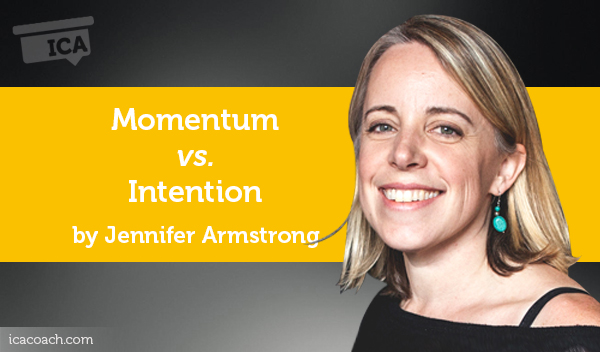
A Coaching Power Tool created by Jennifer Armstrong
(Strategic Planning Coach, UNITED STATES)
When you’re that successful, things have a momentum, and at a certain point you can’t really tell whether you have created the momentum or it’s creating you.
Annie Lennox
Susan was frustrated. For years, she had felt she was unable to get anything done. “I’m always so busy,” she said at a coaching session. “And yet, I really don’t do anything. I never get done what I say I’m going to get done. I guess I’m just lazy.”
As she and her coach explored what was going on, however, her perspective changed. While she had been blaming herself for her inability to move forward by judging herself as lazy, it was really a matter of the choices she was making – or not making.
She was allowing herself to be moved to act by the momentum in her life – by expectations of others, feelings of obligation, emotional reactions, long-time habits and an underlying commitment to being available to others in her life. By allowing momentum to move her, she was unwittingly inhibiting her intentions from being the source of her action.
She worked with her coach to clarify her intentions, as well as the forces that were creating the momentum that kept her from being free to move forward. With this awareness, she was able to make choices about how she used her time. Rather than being moved by momentum, she could move forward with intention.
According to the Merriam-Webster Dictionary, momentum is defined as “a property of a moving body that determines the length of time required to bring it to rest when under the action of a constant force or moment”, or “the strength or force gained by motion or by a series of events.”
While the origin of the concept is physical, having to do with the mass and motion of a physical object, the principal can be applied to the action or “movement” of individuals or organizations.
We create momentum in our lives or organizations when we allow internal and external forces to exert pressure that moves us to action. These forces may include commitments, routines, habits, emotions, beliefs and more. While these forces may or may not be intentionally chosen at first, over time, these forces often remain present, pushing us forward – even after they are no longer relevant to our current intentions.
Intention, on the other hand, is defined by Merriam-Webster as “a determination to act in a certain way, or what one intends to do or bring about.”
When we act out of intention, we act with purpose in a way that aligns with our goals.
In the example above, Susan was busy because of the momentum of her life. That momentum was caused by habits and routines she had developed years before and simply continued without ever stopping to question whether they were still relevant. The momentum was also caused by her sense of obligation to those routines and her commitment to supporting the people in her life – whether or not they still needed her to be available like they once had. This momentum propelled her to move forward, always in motion. That motion and the forces behind it overpowered her attempts to move forward in new ways.
The same can be true in the life of an organization.
A charity executive engaged a coach because he was frustrated that the organization wasn’t making the difference they once had. “Nothing has changed,” he said. “We’re doing exactly what we’ve always done, but for some reason, we seem to be losing ground.”
When he and his coach looked closer, he realized that the environment around his organization had changed. They had been so focused on their commitment to stability and consistency, that they had not considered that their work was pure momentum. While the work they did was based on their intentions, they had not stopped to consider whether their intentions were still relevant. After working with his coach and the rest of his leadership team, they realized that their previous mission was losing relevance because the needs of their clients were changing. They established new intentions and then worked to shift momentum to support their new purpose.
These examples illustrate what can happen when we move due to momentum rather than intention. Momentum propels us forward. It causes us to act; it allows us to make progress. Momentum, when created intentionally, can be a very powerful tool for creating desired progress.
However, by its nature, momentum is hard to stop. It keeps moving forward, pushing, pushing – in the process, consuming our time, energy, attention and resources to move in any other way. And if that momentum is not – or no longer – in alignment with our intentions, it can keep us from being able to succeed in the ways that we intend.
Self Application
These days, many of us are very busy. We are constantly moving, constantly doing. And yet, we feel unfulfilled, unsatisfied, unmoved. We use words like “running on autopilot,” “on the treadmill of life,” and “in the rat race” to describe our state of constant motion without ever really getting where we want to go.